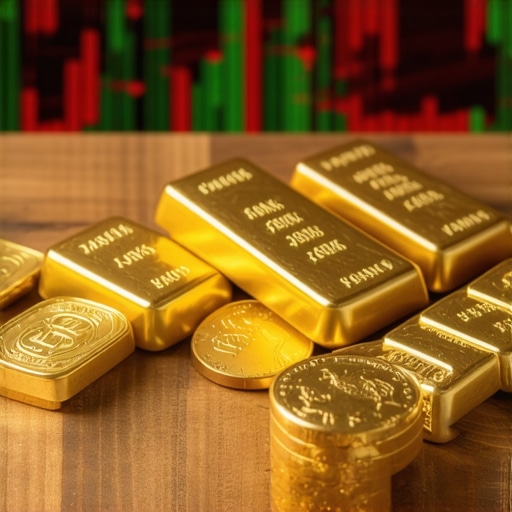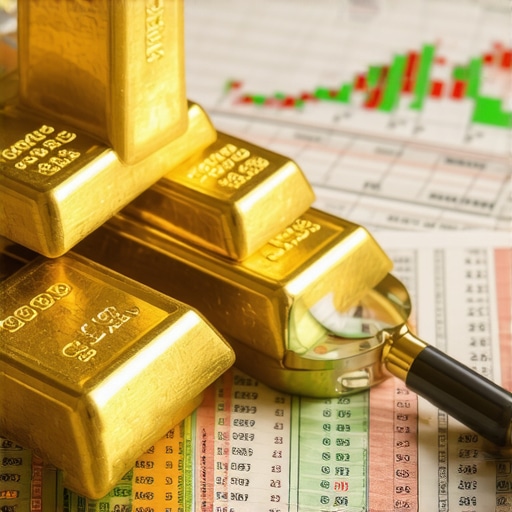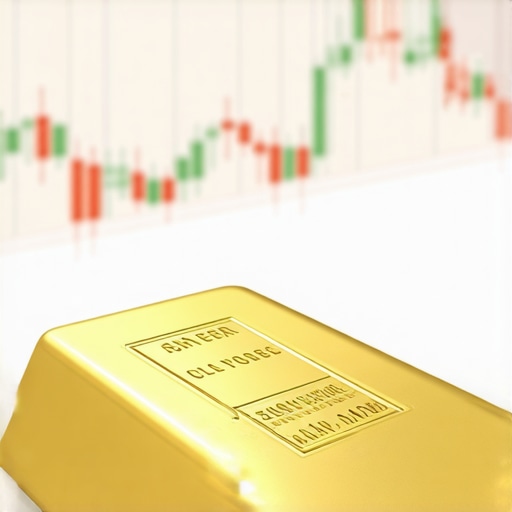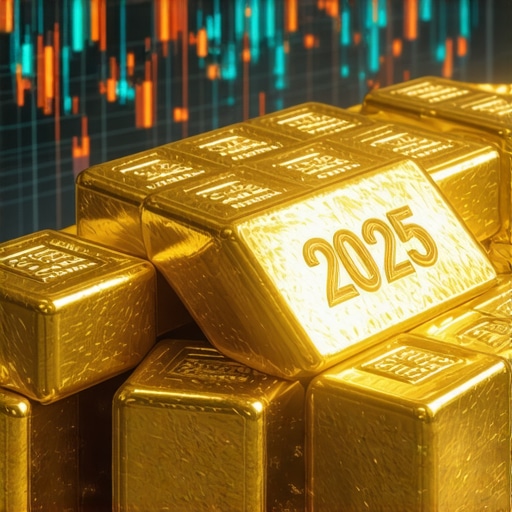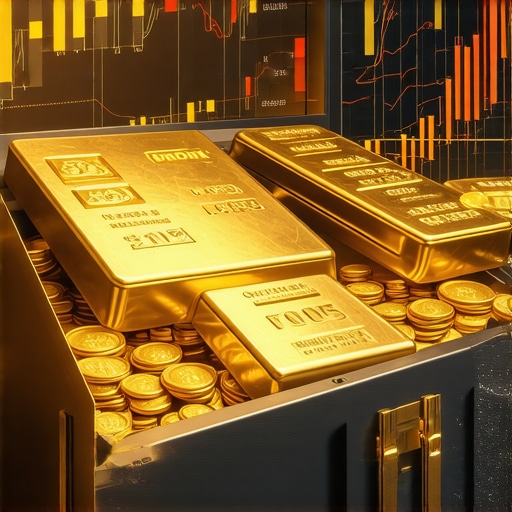Strategic Insights into Gold Investment for 2025: Navigating Market Dynamics with Expertise
As we approach 2025, the landscape of gold investment demands a nuanced understanding of market trends, geopolitical influences, and emerging demand drivers. For seasoned investors and financial strategists, selecting the optimal gold coins and bullion options is critical for wealth preservation and growth. This comprehensive guide synthesizes expert insights on the most promising assets, leveraging in-depth analysis of supply-demand dynamics, central bank policies, and macroeconomic indicators.
Deciphering the Evolving Gold Market: Key Factors and Future Price Drivers
What are the most influential factors shaping gold prices in 2025?
According to recent market forecasts, geopolitical tensions, inflationary pressures, and central bank gold acquisitions continue to be pivotal. The interplay of these elements creates complex scenarios where gold acts as a hedge against systemic risks. Investors must monitor emerging demand trends, such as jewelry consumption and technological applications, which significantly influence supply-demand equilibrium.
Optimal Gold Coins and Bullion Options for Wealth Growth in 2025
From a strategic perspective, selecting high-liquidity gold coins like the American Gold Eagle, Canadian Gold Maple Leaf, and South African Krugerrand remains advantageous due to their recognition and premium liquidity. For bullion, considerations extend to .9999 fine gold bars, which offer purity and ease of storage. For those seeking diversification, gold-backed ETFs and mining stocks provide alternative exposure aligned with long-term growth objectives.
Expert-Driven Portfolio Construction: Balancing Safety and Growth
Developing a resilient gold investment portfolio entails integrating physical assets with derivatives and equities. Resources such as building a gold portfolio should be tailored to risk tolerance and market outlook. Emphasizing safety, liquidity, and appreciation potential ensures robustness amid volatility.
How Can Advanced Traders Maximize Returns in 2025?
Leveraging technical analysis, futures contracts, and market timing strategies enhances profit margins. Effective use of futures and technical tools allows traders to navigate market fluctuations. Active management combined with expert insights into emerging demand trends can significantly outperform static buy-and-hold approaches.
Expert Inquiry: How does the interplay between global economic policies and gold demand influence price trajectories in 2025?
Understanding this relationship requires an analysis of central bank policies, currency stability, and geopolitical risks. Central banks’ ongoing gold purchases, as detailed in policy reports, are likely to underpin upward price momentum, especially in times of economic uncertainty.
For professionals aiming to refine their strategies further, exploring long-term development approaches offers valuable insights. Engage with expert communities and contributing opinions to stay ahead in this dynamic market.
Explore more about optimizing your gold investment in 2025 at top coins and bullion and harness the full potential of your wealth strategy.
Unlocking Nuanced Opportunities: How Can Investors Leverage Geopolitical Shifts for Gold Gains in 2025?
In 2025, geopolitical tensions and international policy shifts will continue to influence gold’s trajectory, making it essential for savvy investors to stay informed about global developments. Understanding the subtle impacts of trade disputes, regional conflicts, and diplomatic negotiations can reveal unique entry points and hedging opportunities. For instance, increased sanctions or trade restrictions often stimulate gold demand as a safe haven, especially when currency stability is threatened. Experts recommend monitoring geopolitical risk indices and aligning these insights with market timing strategies to optimize entry and exit points.
Holistic Portfolio Strategies: Integrating Physical Gold with Sophisticated Financial Instruments
Building an investment portfolio that balances physical gold with derivatives such as futures, options, and gold ETFs can significantly enhance returns while managing risks. Advanced investors should explore comprehensive portfolio development frameworks, emphasizing diversification across asset classes. Combining tangible assets with financial derivatives allows for agile responses to market volatility, capitalizing on short-term movements while maintaining long-term growth potential. Consideration of liquidity, tax implications, and storage security is vital in designing a resilient gold investment structure.
What are the emerging technological trends that could influence gold’s role in digital and traditional markets in 2025?
Technological innovations, including blockchain-based gold tokens and digital gold platforms, are poised to redefine liquidity and accessibility. These platforms facilitate secure, transparent transactions, expanding gold’s reach to a broader investor base. The integration of blockchain technology enhances traceability and reduces fraud risk, fostering greater confidence among institutional and retail investors alike. As per recent analyses from industry reports, embracing these innovations can diversify investment channels and improve portfolio performance. Keeping abreast of regulatory developments in digital assets is equally crucial, as policies will shape the evolution of gold-related fintech solutions.
Explore more about developing a long-term gold strategy and integrate these emerging trends to stay ahead. Sharing your insights or questions in the comments can spark valuable discussions on how to adapt investment approaches in this dynamic environment.
Harnessing Technological Innovations to Revolutionize Gold Investment in 2025
As the financial landscape evolves, technological advancements are transforming how investors access and manage gold assets. Blockchain-based platforms, digital gold tokens, and decentralized finance (DeFi) applications are emerging as powerful tools to enhance liquidity, transparency, and security. These innovations enable seamless transactions across borders, reduce counterparty risk, and open new avenues for diversification. Industry leaders, such as the London Bullion Market Association (LBMA), are actively developing standards to regulate digital gold, ensuring investor confidence and market integrity.
Moreover, integrating artificial intelligence (AI) and big data analytics into investment strategies allows for more precise market predictions and risk assessments. For instance, AI algorithms can analyze geopolitical developments, currency fluctuations, and macroeconomic indicators to forecast short-term price movements. Combining these insights with traditional technical analysis creates a hybrid approach that optimizes timing and entry points. This synergy between cutting-edge technology and foundational investment principles positions savvy investors to capitalize on fleeting opportunities.
How do digital gold platforms impact traditional gold investment paradigms?
Digital gold platforms significantly lower barriers to entry by offering fractional ownership, real-time trading, and enhanced liquidity. Unlike physical gold, which requires storage and insurance considerations, digital tokens can be stored securely on blockchain wallets, reducing logistical complexities. According to a comprehensive report by the World Gold Council (2024), the adoption of digital gold increased by 45% globally, reflecting growing investor confidence in these instruments. This shift not only democratizes access but also aligns with the broader trend of digital transformation in finance.
However, investors must remain vigilant regarding regulatory developments, as jurisdictions worldwide are establishing frameworks to govern digital assets. Staying informed through authoritative sources like the International Monetary Fund (IMF) and regional financial regulators is crucial for navigating this rapidly evolving sector.
Emerging Market Dynamics: How Geopolitical Shifts Shape Gold Demand in 2025
Geopolitical tensions, trade disputes, and regional conflicts continue to exert profound influence on gold demand. For example, escalating tensions in Eurasia and the Middle East often lead to increased central bank gold purchases as a safe haven. As detailed in the IMF’s 2024 Global Financial Stability Report, such scenarios tend to trigger short-term surges in gold prices, followed by sustained interest from institutional investors seeking portfolio diversification.
Furthermore, emerging markets like India and China are experiencing rapid growth in jewelry and technology-related gold consumption. These demand drivers are frequently synchronized with local economic policies, inflation rates, and currency stability. Investors aiming for long-term gains should analyze these regional trends comprehensively, leveraging data from institutions like the World Gold Council and regional central banks.
Understanding the nuanced interplay between geopolitical risks and market sentiment can reveal strategic entry and exit points, especially when combined with advanced technical analysis tools and real-time news analytics. This layered approach ensures that investors are not only reacting to current events but also anticipating future shifts in demand patterns.
Integrating Physical and Digital Gold: Crafting a Resilient Portfolio in 2025
Building a resilient gold investment portfolio involves balancing physical assets with digital and financial instruments. Physical gold provides tangible security and a hedge against systemic risks, while digital tokens offer liquidity and ease of transfer. Incorporating gold-backed ETFs, futures, and options enhances flexibility and allows for tactical positioning based on market conditions.
Advanced investors should explore multi-asset strategies that incorporate derivatives to hedge against volatility and leverage leverage opportunities. For example, options contracts can protect gains or generate income during sideways markets, while futures enable precise exposure to anticipated price movements. As noted by the CFA Institute (2024), such strategies require rigorous risk management protocols and a deep understanding of market interconnectedness.
Additionally, considering the role of tax implications and storage security is vital in designing an effective gold portfolio. Diversification across asset classes and geographic regions can mitigate localized risks, ensuring that the portfolio remains robust amidst global uncertainties.
What are the best practices for leveraging digital tools to optimize gold investment strategies in 2025?
Utilizing advanced analytics platforms, real-time news feeds, and automated trading algorithms can significantly enhance decision-making. Regularly updating your knowledge base through authoritative sources like the World Gold Council, IMF, and regional regulators ensures that your strategies remain aligned with current market realities. Engaging with expert communities and participating in webinars or forums can also provide valuable insights into emerging trends and technological developments.
If you’re committed to refining your gold investment approach, consider subscribing to industry reports and leveraging financial advisory services specializing in precious metals. Continuous education and strategic adaptation are the cornerstones of success in this dynamic market environment.
Harnessing the Power of Geopolitical Intelligence for Gold Price Forecasting in 2025
In the complex realm of precious metals, geopolitical intelligence serves as a crucial pillar in forecasting gold price trajectories. Sophisticated investors leverage real-time geopolitical risk indices, regional conflict analysis, and diplomatic developments to identify strategic entry and exit points. For instance, heightened trade tensions or regional conflicts often catalyze short-term surges in gold demand, which can be anticipated through comprehensive geopolitical monitoring systems. According to insights from the World Policy Center, integrating geopolitical risk assessments with macroeconomic data enhances predictive accuracy, enabling investors to capitalize on market volatility with precision.
Innovative Financial Instruments: Unlocking New Dimensions of Gold Portfolio Optimization
Beyond traditional holdings, cutting-edge financial instruments such as gold options, futures, and innovative ETFs offer unparalleled flexibility for seasoned investors. These tools facilitate tactical hedging against macroeconomic uncertainties and enable leveraging short-term market movements. For example, deep dives into CFA Institute’s research highlight how employing options strategies can generate income or protect gains during sideways markets. The integration of these derivatives within a diversified portfolio amplifies resilience, especially when combined with physical assets and digital gold tokens, as discussed in recent industry reports.
What are the critical technological advancements influencing gold trading platforms in 2025?
Emerging technologies like blockchain, AI-driven analytics, and decentralized finance are revolutionizing gold trading platforms. Blockchain enhances transparency and traceability, enabling fractional ownership and seamless cross-border transactions. AI algorithms facilitate high-frequency trading, predictive analytics, and risk management, dramatically improving decision-making precision. The rise of decentralized finance (DeFi) platforms introduces new liquidity pools and yield-generating opportunities for gold investors. An authoritative source, the World Gold Council, emphasizes that embracing these innovations is critical for maintaining a competitive edge in the evolving landscape of gold investment.
How can investors effectively diversify their gold holdings across physical and digital domains in 2025?
Effective diversification involves a strategic blend of physical gold, digital tokens, and financial derivatives. Physical gold offers tangible security, hedging systemic risks, while digital gold tokens provide liquidity, transparency, and fractional ownership. Incorporating gold-backed ETFs, mining stocks, and futures contracts further enhances portfolio robustness. This hybrid approach mitigates risks associated with storage, insurance, and liquidity constraints, while maximizing exposure to potential price gains. Industry experts advocate for continuous monitoring of regulatory developments and technological trends to adapt diversification strategies in real time.
What advanced analytical techniques can refine gold investment timing and risk management?
Utilizing machine learning models, sentiment analysis, and big data analytics enables investors to identify subtle market signals and macroeconomic shifts ahead of time. These techniques analyze geopolitical developments, currency fluctuations, and macroeconomic indicators to forecast short-term price movements with high precision. Combining these insights with traditional technical analysis creates a hybrid strategy that optimizes market timing and risk mitigation. Engaging with authoritative data sources such as the IMF and regional financial regulators ensures that analytical models remain aligned with current market realities.
To deepen your expertise and stay ahead of market shifts, consider subscribing to specialized industry reports and participating in expert forums. Continuous education and technological integration are vital for mastering the evolving landscape of gold investment in 2025.
Expert Insights & Advanced Considerations
1. Geopolitical Dynamics Will Continue to Drive Demand
Geopolitical tensions and regional conflicts are likely to sustain gold’s status as a safe haven asset, impacting prices and investment strategies. Staying informed on global risk factors enables proactive positioning.
2. Technological Innovations Will Expand Access
Blockchain-based gold tokens and digital platforms will revolutionize liquidity and transparency, opening new avenues for diversified investment approaches and fractional ownership.
3. Central Bank Policies Will Remain Pivotal
Central bank gold purchases and reserve management strategies will significantly influence market trends, emphasizing the importance of monitoring policy shifts for strategic entry and exit points.
4. Market Sentiment and Data Analytics Will Gain Greater Clout
Advanced analytics, AI-driven forecasts, and sentiment analysis will become integral to timing and risk management, allowing investors to navigate volatility with increased confidence.
5. ESG Factors Will Shape Investment Choices
Environmental, Social, and Governance considerations will influence gold mining and procurement decisions, aligning portfolio strategies with sustainability trends and investor preferences.
Curated Expert Resources
- World Gold Council: Offers authoritative insights on demand trends, market data, and industry innovations, essential for deep market understanding.
- IMF Reports: Provides macroeconomic analyses and geopolitical risk assessments, vital for strategic decision-making.
- Financial Industry Regulatory Authorities: Guides on digital gold regulation, ensuring compliance and security in emerging markets.
- Industry Think Tanks & Journals: Such as CFA Institute publications, offering cutting-edge research on derivatives, analytics, and market strategies.
- Blockchain & Fintech Platforms: Leading providers like Goldbacked and Republic Protocol for digital gold trading and fractional ownership insights.
Final Expert Perspective
In the complex landscape of gold investment for 2025, integrating geopolitical intelligence, technological innovation, and macroeconomic insights will be paramount. Recognizing the nuanced interplay of these factors empowers investors to craft resilient, high-performing portfolios that capitalize on emerging opportunities. Staying engaged with authoritative resources and leveraging advanced analytics will distinguish astute investors from the pack. As always, continuous learning and strategic adaptation remain the cornerstone of success in this dynamic market. Engage with industry experts, explore innovative tools, and refine your approach to secure a competitive edge—because in gold investment, knowledge is the most valuable asset.






